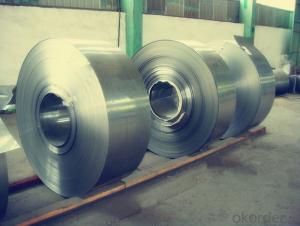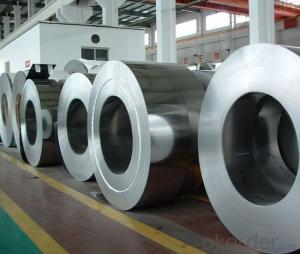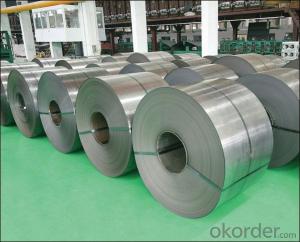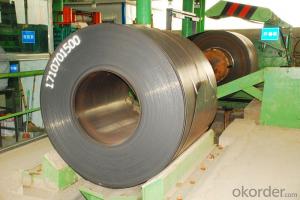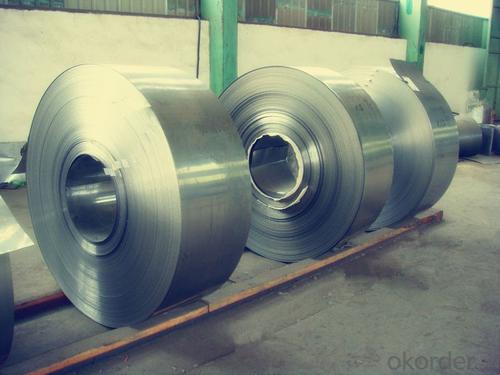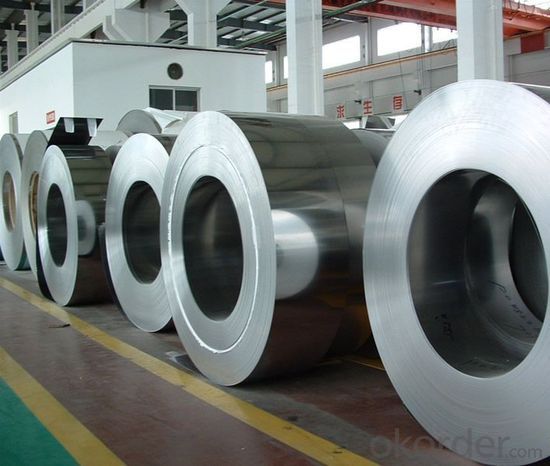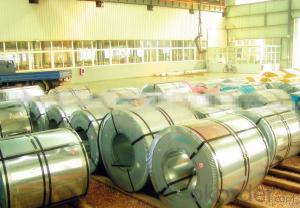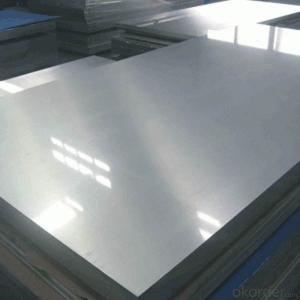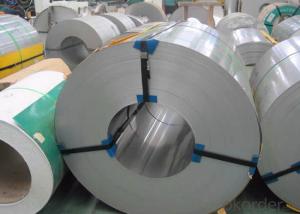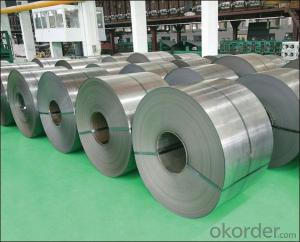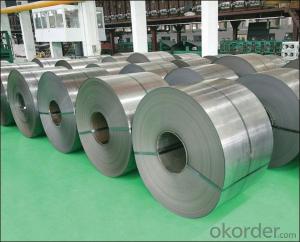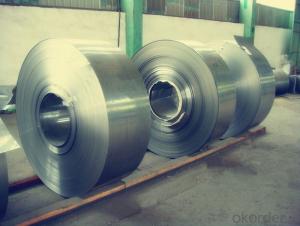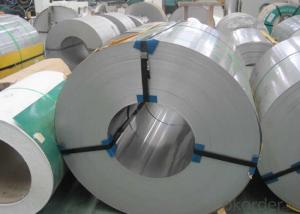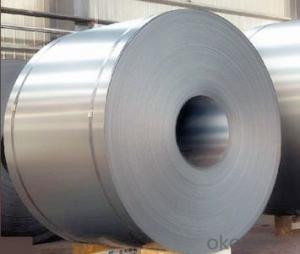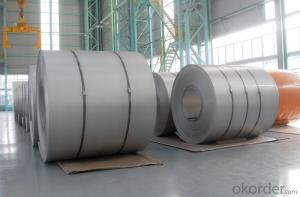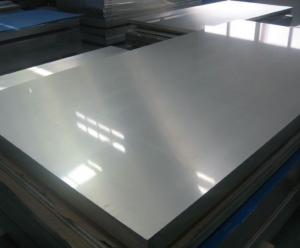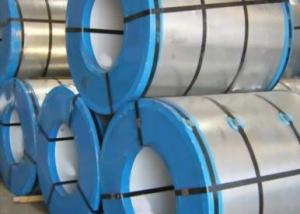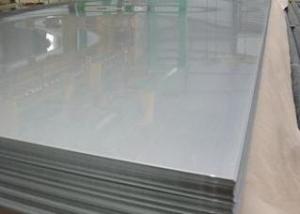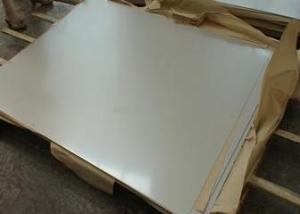Hot Rolled Stainless Steel Coil 201 No.1 Finish
OKorder Service Pledge
OKorder Financial Service
You Might Also Like
Hot Rolled Stainless Steel Coil 201 No.1 Finish
Hot Rolled Stainless Steel 201 half copper Chemical Composition(%) | |||||||
C | Si | Mn | P | S | Ni | Cr | Cu |
0.1 | 0.5 | 10 | 0.04 | 0.01 | 1.20/1.30 | 13.00/14.00 | 0.8/1.0 |
Grade: | 200 Series | Standard: | JIS,AISI,ASTM,GB,DIN | Thickness: | 2.5/3.0/4.0mm |
Width: | 485/510/550/610/1010/1240mm | Place of Origin: | Shanghai China (Mainland) | Brand Name: | CNBM |
Model Number: | 201 | Technique: | Hot Rolled | Application: | Industrial tubes/kitchen/bath |
Certification: | ISO | THK: | 2.5/3.0/4.0mm | Face: | No.1 |
Usage: | tubes/kitchen/bath | Origin: | CHINA | ||
Packaging Detail: For customer's requirement
Delivery Detail:10-30days
201 Hot Rolled Stainless Steel Coil Specifications
THK:2.3/2.5/3.0/4.0mm
Width:485/510/550/610/1010/1240mm
Face:No.1
201 Hot rolled stainless steel Coil Application
Stainless steel is a production which not easy rust,acid resistance and corrosion resistance,so it is widely
used in light industry,heavy industry,daily necessities and the decoration industry.201 hot rolled stainless steel coil, use to produce cold rolled stainless steel coil and stainless steel tube, pipe.
201 Hot Rolled Stainless Steel Coil
Strength Of Extension:100,000 To 180,000 Psi;
Yield Strength:50,000 To 150,000 Psi
Elongation :55 To 60%;
Modulus Of Elasticity:29,000,000 Psi;
Density :.280lbs/Cubic Inch(7.93g/Cm3)
- Q: What are the different types of edges available for stainless steel strips?
- There are several different types of edges available for stainless steel strips, depending on the specific application and desired appearance. Some common types of edges include: 1. Mill Edge: This is the standard edge produced during the manufacturing process. It has a smooth, straight finish with no additional processing or treatment. 2. Slit Edge: This edge is created by cutting the stainless steel strip to the desired width using a slitting machine. It typically has a slight burr or roughness along the edge, which can be removed through deburring or other finishing processes. 3. Rounded Edge: Also known as a round edge or rolled edge, this type of edge is created by rolling the stainless steel strip to give it a curved or rounded profile. It provides a safer and more comfortable edge, making it suitable for applications where sharp edges could pose a risk. 4. Deburred Edge: This edge is achieved by removing any burrs or roughness from the edge of the stainless steel strip. Deburring is typically done using specialized equipment or processes to ensure a smooth and clean finish. 5. Beveled Edge: A beveled edge is created by cutting the stainless steel strip at an angle, usually 45 degrees, to create a sloping or chamfered edge. This type of edge is often used for aesthetic purposes or to facilitate welding or joining of the strips. 6. Custom Edges: Depending on the specific requirements of a project or application, custom edges can also be created. These may include different profiles, finishes, or treatments to meet specific functional or aesthetic needs. It is important to consider the intended use and requirements of the stainless steel strips when selecting the appropriate edge type. The choice of edge can impact the performance, appearance, and safety of the final product.
- Q: Are 111 stainless steel strips suitable for the food and beverage industry?
- Yes, 111 stainless steel strips are suitable for the food and beverage industry.
- Q: What are the different types of coatings available for stainless steel strips?
- There are several different types of coatings available for stainless steel strips, including epoxy coatings, vinyl coatings, polyurethane coatings, and acrylic coatings. These coatings provide protection against corrosion, enhance durability, and improve the aesthetics of stainless steel strips.
- Q: Can stainless steel strips be used in electrical applications?
- Yes, stainless steel strips can be used in electrical applications. Stainless steel is known for its high resistance to corrosion and heat, making it suitable for various electrical components like connectors, terminals, and conductors. Additionally, stainless steel's excellent mechanical properties and conductivity make it a reliable choice for applications where electrical conductivity and durability are required.
- Q: Are stainless steel strips easy to form and shape?
- Yes, stainless steel strips are relatively easy to form and shape. Stainless steel is known for its excellent formability, which means it can be easily manipulated into various shapes and sizes without losing its structural integrity. This is due to its unique composition, which includes a high percentage of chromium that provides corrosion resistance and makes it more malleable compared to other types of steel. Additionally, stainless steel strips can be cold worked, meaning they can be bent, twisted, and stretched at room temperature without the need for heat treatment. These characteristics make stainless steel strips a popular choice in various industries, such as automotive, construction, and manufacturing, where they are used for applications that require precise shaping and forming.
- Q: How do stainless steel strips compare to aluminum strips in terms of strength?
- Compared to aluminum strips, stainless steel strips generally possess higher strength. Stainless steel is renowned for its exceptional strength and durability, rendering it appropriate for diverse applications necessitating resistance to corrosion, heat, and impact. Conversely, aluminum strips exhibit relatively less strength; however, they are lightweight and boast commendable corrosion resistance. Although aluminum strips may not rival the strength of stainless steel, they are frequently favored in weight-sensitive industries like aerospace and automotive. Ultimately, the selection between stainless steel and aluminum strips hinges upon the precise requirements of the application, striking a balance between strength, weight, and other properties.
- Q: Can stainless steel strips be used in elevator doors?
- Yes, stainless steel strips can be used in elevator doors. Stainless steel is a popular choice for elevator doors due to its durability, corrosion resistance, and aesthetic appeal. It provides a sleek and modern look while also withstanding the wear and tear associated with elevator usage.
- Q: Can stainless steel strips be used in the food and beverage industry?
- Yes, stainless steel strips can be used in the food and beverage industry. Stainless steel is widely used in this industry due to its corrosion resistance, durability, and hygienic properties. It is commonly used to manufacture equipment such as food processing machinery, storage tanks, conveyor systems, and brewing equipment. Stainless steel strips are versatile and can be formed into various shapes and sizes, making them suitable for a wide range of applications in the food and beverage industry.
- Q: Can stainless steel strips be soldered?
- Soldering stainless steel strips can be accomplished, but it necessitates specific methods and materials. Due to its high melting point and low thermal conductivity, conventional soldering techniques may not yield satisfactory results. Nevertheless, it is achievable to solder stainless steel by utilizing dedicated fluxes and solders that are specially designed for this purpose. These products are typically composed of nickel or silver alloys, which have a lower melting point compared to stainless steel. Moreover, the stainless steel surface might need to undergo preparation through abrasives or chemical treatments to enhance adhesion. In summary, soldering stainless steel necessitates the use of specialized equipment and materials, but it is certainly feasible when employing the appropriate techniques and products.
- Q: Can stainless steel strips be easily welded?
- Certainly, welding stainless steel strips is a breeze. Renowned for its remarkable weldability owing to its elevated melting point, limited thermal conductivity, and commendable heat resistance, stainless steel shines. TIG (Tungsten Inert Gas) welding and MIG (Metal Inert Gas) welding are the go-to techniques for welding stainless steel strips. These methods facilitate meticulous regulation of the welding procedure and yield robust and long-lasting welds. Furthermore, stainless steel strips frequently find their way into diverse sectors such as automotive, construction, and manufacturing, where welding serves as a prevalent method of joining.
Send your message to us
Hot Rolled Stainless Steel Coil 201 No.1 Finish
OKorder Service Pledge
OKorder Financial Service
Similar products
Hot products
Hot Searches
Related keywords
